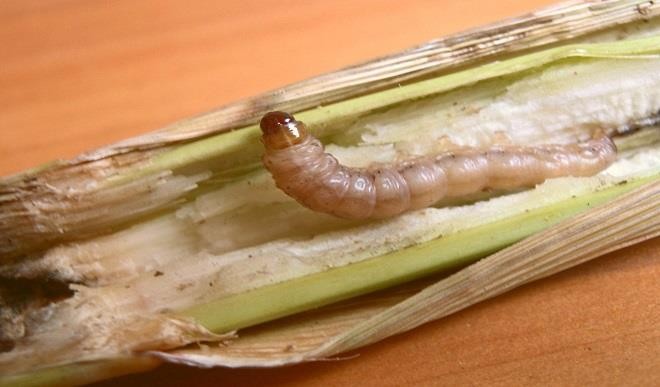What you need to know about stem-borers – Expert
Could you give us brief description of stem-borer and what it does to crops? Stem-borer is a larval stage of a group of insects known as lepidopterans. They are the butterflies and moths that we see. The adult female lays eggs which hatch into young larvae or caterpillars and they start feeding on the leaves […]


Could you give us brief description of stem-borer and what it does to crops?
Stem-borer is a larval stage of a group of insects known as lepidopterans. They are the butterflies and moths that we see. The adult female lays eggs which hatch into young larvae or caterpillars and they start feeding on the leaves of the crop after which they get to the growing portion of the crop. From that growing portion, they will move into the stem and feed right inside the stem, and when they complete their development, they make a hole through which they come out, that is why they are called stem-borers. They are commonly found on cereal crops like maize, sorghum, millet and rice and can cause damage of about 50 to 80%. Attacks are more severe on late planted maize.
What are the common symptoms of stem-borer’s attack farmer should look out for?
Early symptoms are round holes on the leaves of the crop, particularly maize and sorghum, and then around the growing portion, the fresh leaves at the top. You will find these holes more common around that portion which they kill as they advance, resulting in dead-heart. In advance stages, you also find round holes on the stem and these holes will be blocked by the frass (faeces of the insect). We strongly advice that farmers shouldn’t let the symptoms get to that stage because it will be difficult to control once the stem-borer has gotten into the stem.
When the farmer is visiting his farm, either early in the morning or evening, and he sees butterflies hovering over his crops, he should know that these insects are getting in there. Within one week, if he checks very well on the lower surface of the leaves, he is going to see a small worm eating the leaves, at that stage it is effective to apply chemical because they are still outside and have not gone inside.
There were recent attacks of stem-borers on farms in FCT and Benue State, how can farmers prevent or control future attacks?
The problem of stem-borers in Nigeria is not only seen in Abuja or Benue, it’s actually an outbreak. Even here, in Zaria, and other parts of the North, farmers are complaining about it.
Usually, this group of insects is sporadic pest because they don’t come every year. If you have them this year you may not see them again until after three years or even more.
There are some weather factors that are responsible for the outbreak, for instance, when you have a dry spell, which is when the adult thrives and lay eggs. The problem is even when farmers see these butterflies and moths hovering over their farms, they don’t imagine they could cause any problem and so before they start noticing, the stem is being bored by the insect. But generally, a group of insecticide referred to as systemic, which are absorbed directly into the tissues of the plant and stored for some time are used, so that the stem-borers are picking the chemical when chewing the leaves. There is a chemical powder called Carbaryl, you fetch it in a spoon and apply to the funnel potion of the crop and it’s usually for small-scale farms. For large scale farms, Dimethoate and Chlorpyrifos are applied. The insecticides are sold under different trade names like Jubaili market Dimethoate, as Cyper-Diforce, which is a combination of Cypermethrin and Dimethoate. We normally advice our farmers to work along with extension agent, every state has an agricultural development project whose staff know where there are reputable agrochemical shops because there is a lot of adulteration these days.
Do you have more advice for farmers?
When farmers harvest their crops, they should collect the stalks of maize or sorghum and burn them. In certain places, like in the far North, it’s difficult to adopt that because farmers use the stalks to feed their livestock, making their houses or other domestic uses. But they should gather them into heaps because the ones at the centre will harbour the insect and by the following season, they will come out. Also, farmers should practise crop rotation, like when they plant maize or sorghum this year, they should try and plant a leguminous crop the following year like beans.
